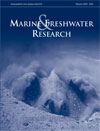Marine and Freshwater Research
Volume 63
Number 3 2012
Bioturbation is an important functional process within marine ecosystems, considerably altering the physical habitat. The effects of stingray pit formation were investigated at Ningaloo Reef and indicated annual sediment turnover rates within our study area of up to 42% and pit longevity was typically < 7days. Our study directly quantifies the effect of stingray bioturbation demonstrating large volumes of sediment turnover, indicating rays fulfil an important ecological role in soft-sediment habitats.
Do Pacific bluefin tuna from the North and South Pacific belong to an identical population? We used molecular markers to test the ‘one-stock’ hypothesis, and high genetic homogeneity appeared between Taiwan and New Zealand samples, indicating that the ‘one-stock’ hypothesis cannot be rejected. To obtain complete population information on the Pacific bluefin tuna, more specimens still need to be collected in the future.
This paper provides the outlook for 14C measurements to show data on stream food webs. We measured δ13C and Δ14C values of periphyton, litter, and dissolved inorganic carbon (DIC) in a stream ecosystem and found that Δ14C signature can precisely discriminate autochthonous and allochthonous carbon sources within reach scales. We discuss how 14C measurements may develop knowledge of stream ecology.
Effective resource management requires an understanding of species’ ranges and how they may shift in response to changing conditions. In this research, we describe patterns in the distribution and abundance of nearshore fishes along the Victorian coastline, and identify an abrupt change in fish communities around Ninety Mile Beach. The marine environment in south-eastern Australia is expected to change dramatically as the effects of global climate change intensify; the findings of this research will allow managers to predict how species may respond to changing conditions, thereby facilitating more effective resource management.
Species niche attributes may modulate the response of passive dispersers to habitat degradation, ultimately affecting metacommunity dynamics. As predicted, the most generalist species had higher occurrences in the impacted area and metacommunity dynamics change accordingly, being more influenced by regional than local factors because generalist species were widely distributed regardless of habitat degradation.
Invasive habitat-forming species modify important environmental factors with major consequences for associated fauna. We examined how the invasive habitat-forming seaweed Caulerpa taxifolia affects anti-predator traits of a native bivalve and found that bivalves in Caulerpa habitat have thinner, weaker shells and low resistance to opening of their valves. These trait modifications are likely to increase their susceptibility to predation.
Lanternfishes (family Myctophidae) are prey for demersal and diving predators that forage in waters surrounding Macquarie Island in the Southern Ocean. The summertime lanternfish assemblage and patterns of distribution are described for the first time. Lanternfish biomass is enhanced where the Subantarctic Front interacts with a break in the topography of the Macquarie Ridge. The oceanographic–topographic interaction is spatially constrained and thus vulnerable to climate-mediated change.
Bathyal cephalopod assemblages in the NW Mediterranean were defined by analysing data from 1985–92 and 2007–2010. We identified three assemblages on the upper (450–600 m), middle (650–1500 m) and lower (1600–2200 m) slopes and evidenced seasonal changes in species abundance and composition. Two environmental variables (primary production and river discharge) best explained the trophic pathways observed.
The research dealt with behavioural adaptation of supralittoral amphipods to different sea water salinities. Talitrus saltator is a widespread species, and its behavioural capability to cope with changes, but at the same time maintaining a basic background, was highlighted throughout this study. Such results can contribute to the building of scenarios of change, with focus on ecotonal environment and populations evolvability.




